Submitted by WA Contents
"Cheap solution is very dangerous" says Diébédo Francis Kéré
Denmark Architecture News - Jul 13, 2023 - 10:00 4063 views
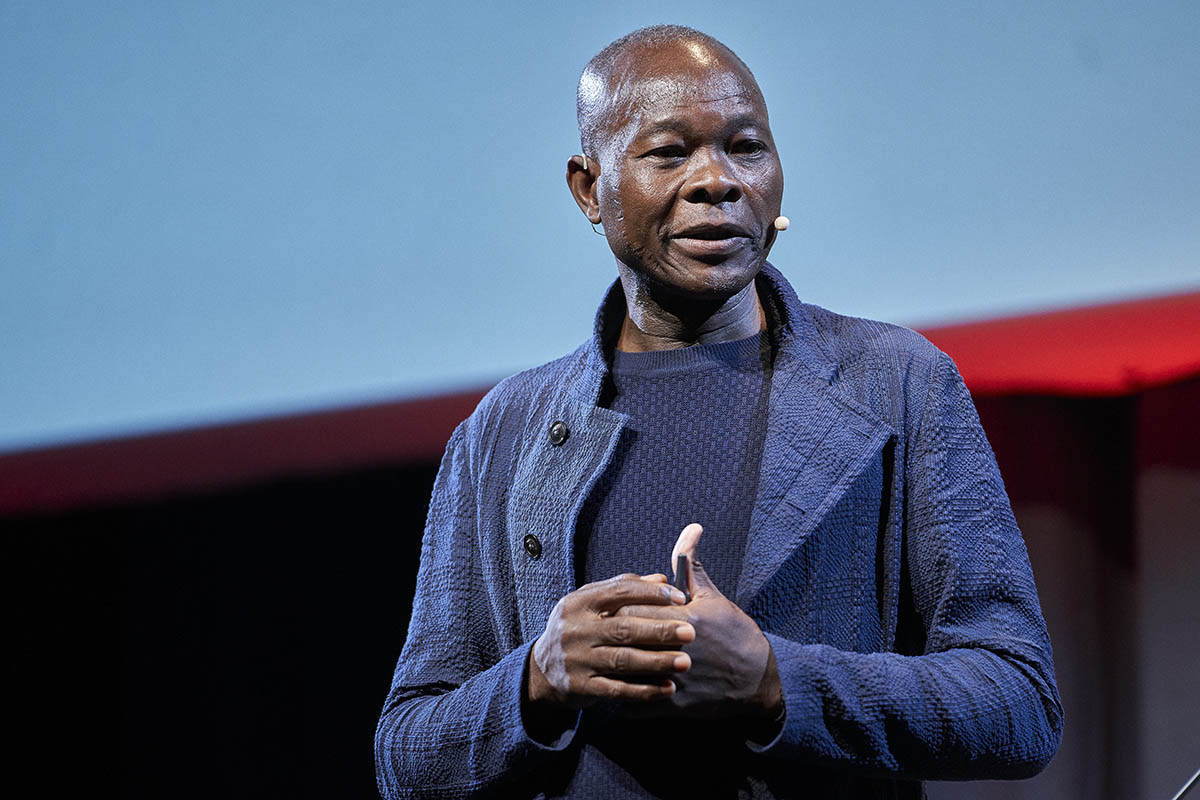
Pritzker Architecture Prize-winning architect Diébédo Francis Kéré underlined that cheap solutions can be very dangerous in architecture and create a disaster at a keynote dialogue the UIA World Congress of Architects in Copenhagen, Denmark.
Noting that he is looking for smart solutions in buildings, he argued that it is more important to add a lifespan to buildings rather than constantly renewing them.
The 28th UIA World Congress of Architects, held from July 2 to 6, 2023 at the Bella Center in Copenhagen, Burkinabè architect Diébédo Francis Kéré spoke in a keynote dialogue with Minik Rosing, Professor of Geology, University of Copenhagen, moderated by Danish politician and Master of Ceremonies Connie Hedegaard.
"Cheap solution is very dangerous"
"Cheap solution is very dangerous," said Diébédo Francis Kéré in a keynote dialogue at the congress.
"If you're using clay in the good way is not always cheaper than the cheap solution that are you presenting. The way you do that it is about lifespan."
"If you add a lifespan in that you will see that it's important to think about a building as a holistic thing. We have to think about the footprint, but it is not about saying we should not build and then a cheap solution can be a disaster. If you have to constantly renew it in short terms then they make no sense."
"It doesn't bring any innovation because you don't change the structure, we keep doing and doing, that's why I'm not proposing for cheap solution - I am proposing for smart solutions. I am proposing for solutions that don't cause a lot of burden to the environment," he added.
"If a building can survive many years like we see in traditional way of building, it is a good solution," Kéré continued.
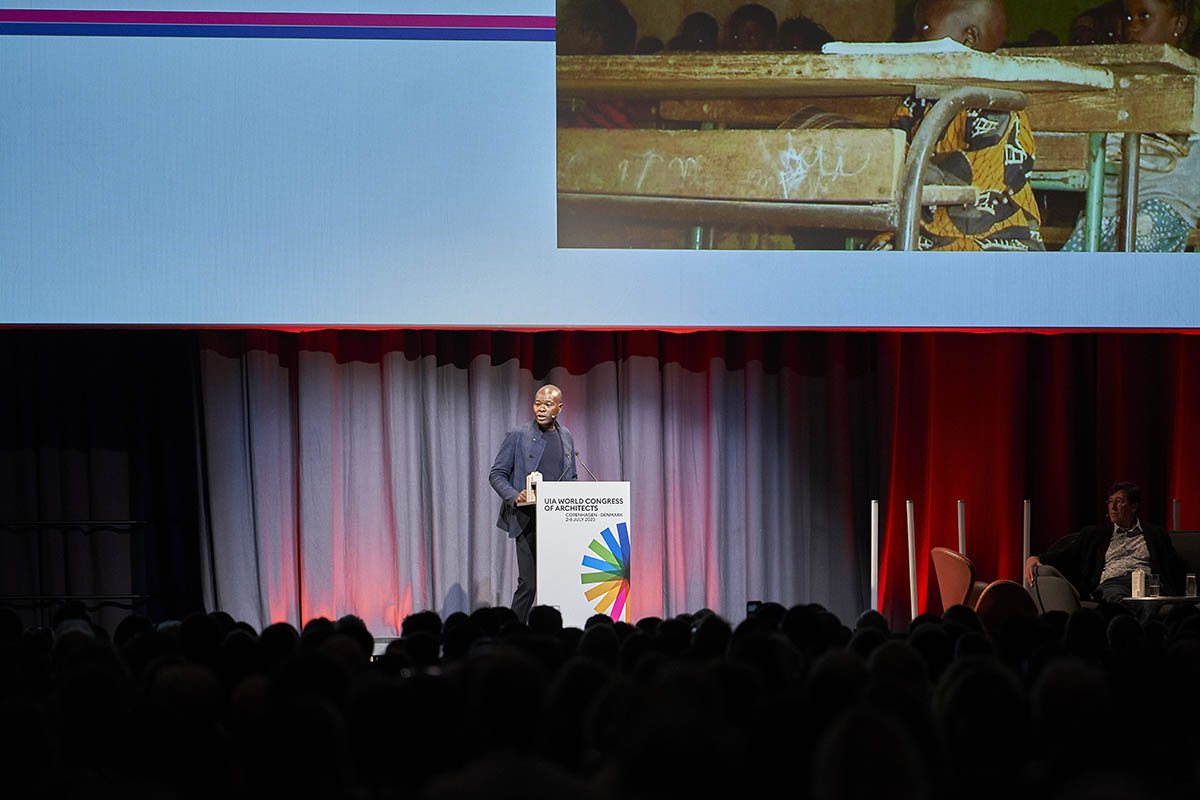
Diébédo Francis Kéré delivered a keynote speech at the UIA World Congress of Architects. Image courtesy of UIA World Congress of Architects 2023
"My way to architecture is unconventional"
The session, titled Rethinking Resources - How To Do More With Less, discussed the new ways of "resourcefulness in architecture and how to bring the built environment back inside the planetary boundaries."
"Our fight to create architecture to shape people's dreams to inspire people and sometimes to make communities happy," said Diébédo Francis Kéré in his keynote speech.
"My way to architecture is unconventional," he said.
Starting his presentation with the examples of his studio Kéré Architecture's proejcts, including Gando Primary School in Burkina Faso, Gando School Library, Xylem in Montana, the 2017 Serpentine Pavilion in London, and Benin's new National Assembly building (set to be completed at the end of 2023), he talked about his journey about how he became an architect.
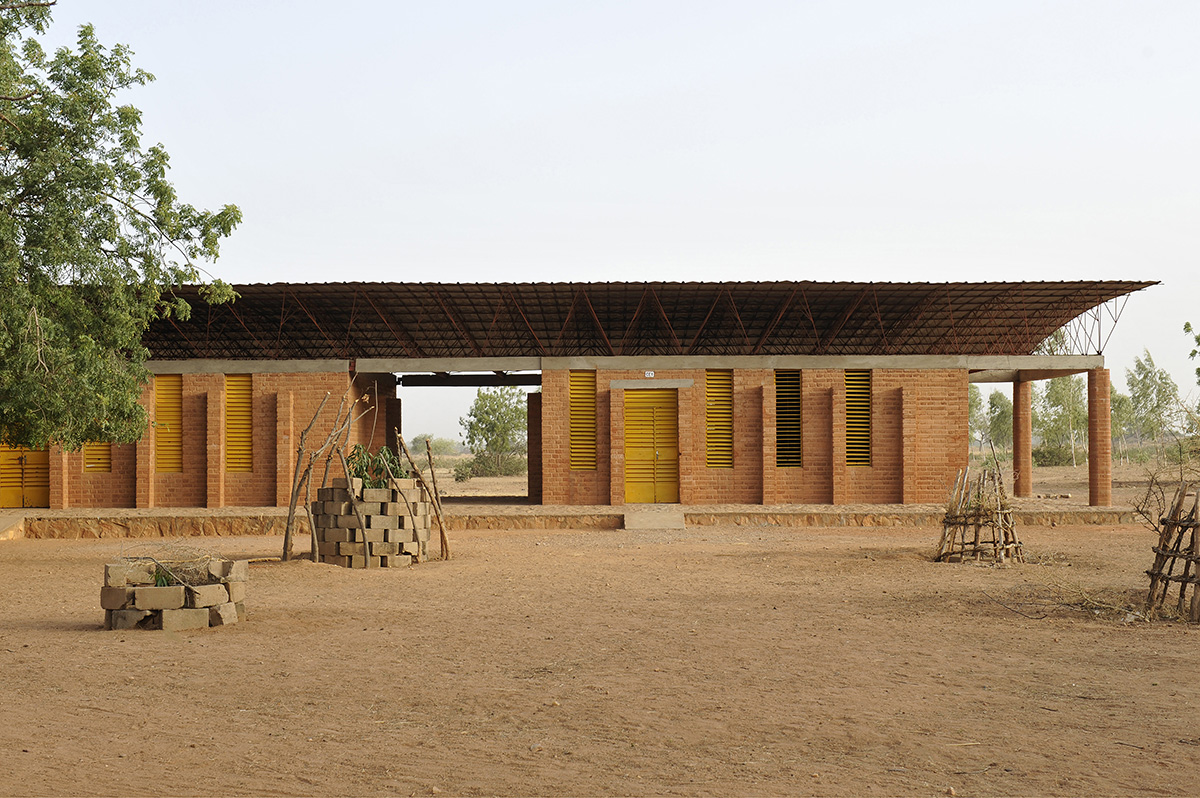
Gando Primary School, Gando, Burkina Faso, 2001. Photo courtesy of Erik-Jan Ouwerkerk
Talking about the construction process of the Gando Primary School he built himself, he explained how he convinced his family to use clay. According to the architect, "clay is the material for poor people."
"I wanted to use rock to create a foundation; a basement and I wanted to introduce new technique using clay. Compact clay blocks, which were modern for my people to look, fancy - it's not glass, it's not concrete but it’s good and with that I succeeded building this school, which is still standing and need no repairs. It was miracle for my people," he added.
"I was even able to introduce so-called primitive techniques to construct a building; a school building which in my home is considered to be something French very modern and needed to be made of concrete and whatever great material that we didn’t have."
"It was a battle train trying testing so first to myself to understand that I understand what I was going to do, I will be able to do it and also to prove to my people that is going to stand and not collapse. So this has been my career, my life," Kéré continued.
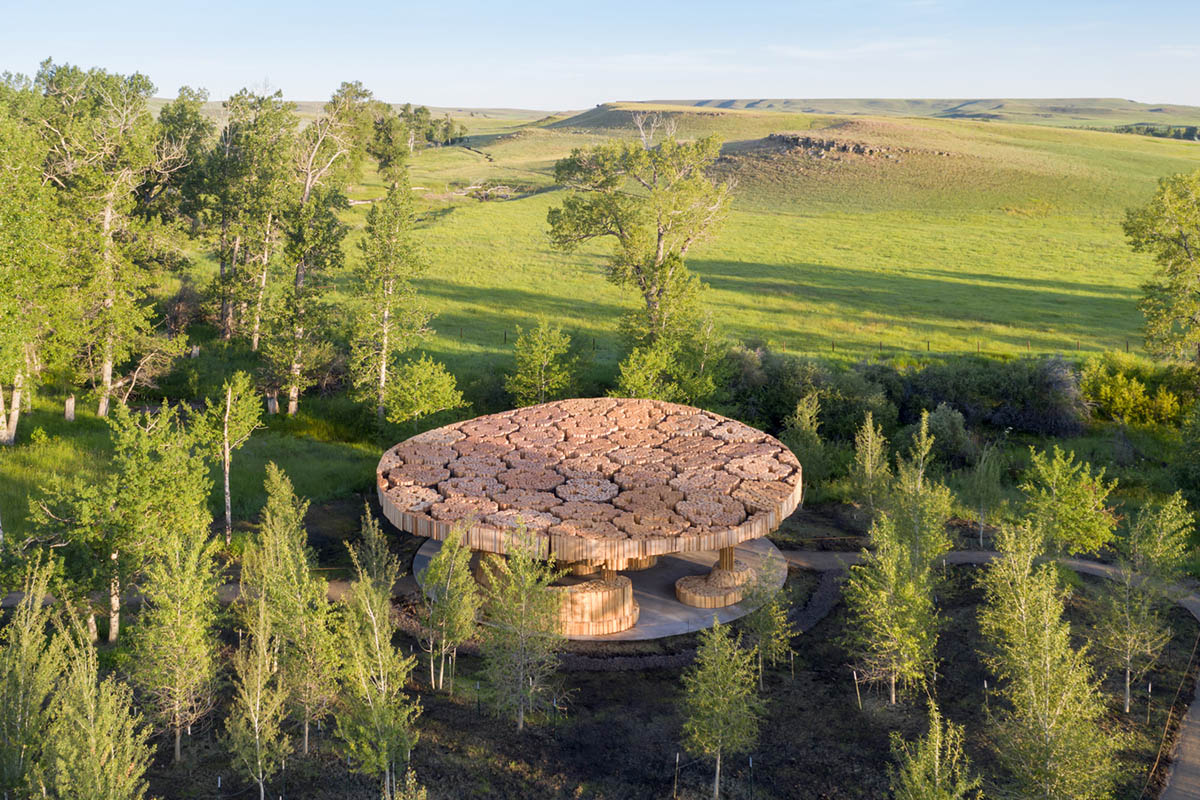
Xylem in Monatan, United States, 2019. Image © Iwan Baan
For his Xylem pavilion in Montana, Diébédo Francis Kéré said that "I was impressed by the availability of wood and then collected them. There was an idea to create a sort of a modular system and you could just put them together."
"The winter can be very hard in Montana, so the summer time and you created a pavilion for visitors – it is standing and could be standing in a hard winter."
"You can do if you really believe in using what is abundant to create structure," he added.
"I’m real carpenter even with concrete"
"That is my idea about how I work and always try to find ways on how to share knowledge. Then inside is clean and people realize it's comfortable and they're looking to have it so from that approach it grows that now I see myself," said Diébédo Francis Kéré.
Kéré descibed himself as a real carpenter, even by using concrete.
"I’m real carpenter even with concrete; I'm starting to weave to decrease the quantity of being smart to create this project," he said.
"With this team, hey guys believe me, in less than 100 years we're going to build it entirely Africa."
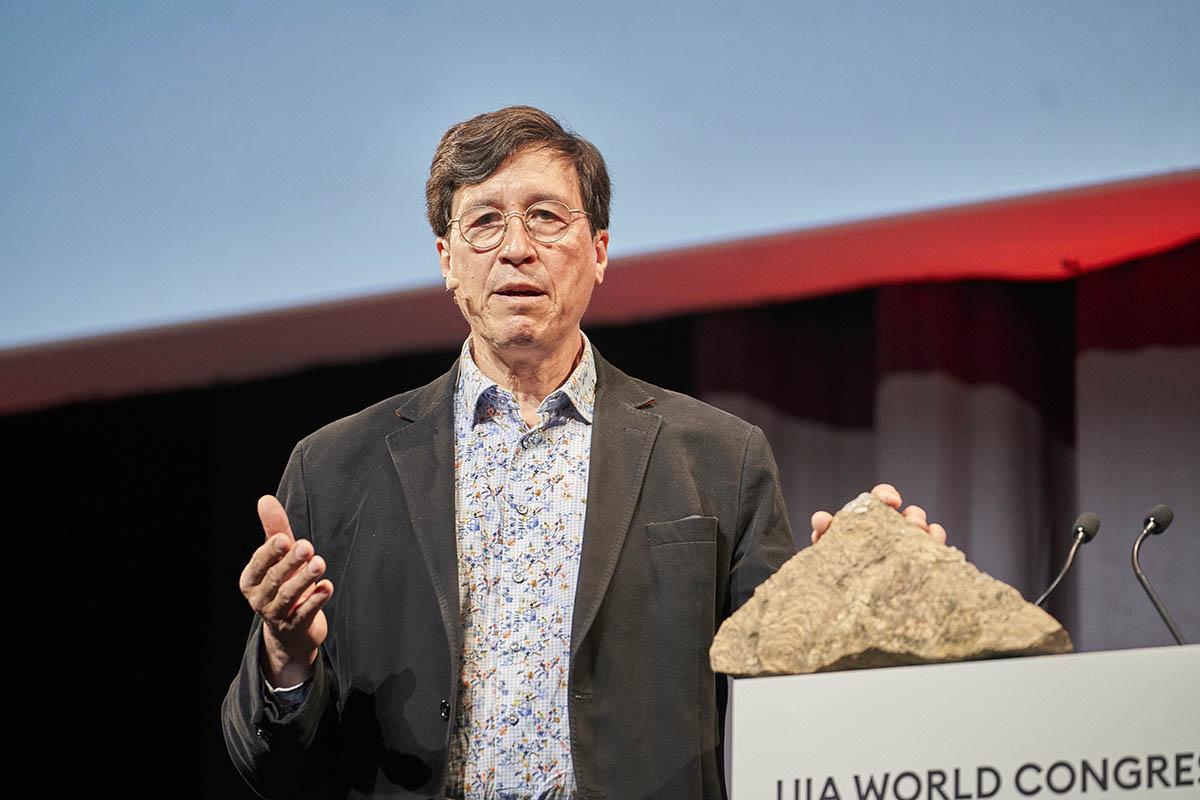
Minik Rosing, Professor of Geology, University of Copenhagen delivered a presentation at the UIA World Congress of Architects. Image courtesy of UIA World Congress of Architects 2023
In the second part of the session, Minik Rosing, Professor of Geology at the University of Copenhagen, delivered a presentation and underlined how brave architecture should be, explaining that how a minimum footprint we could leave on the world.
"The brave architecture of this day and age should be the one that transgresses the solution, the problem-solving mode"
"I think the theme of this of this conference is how we can lower the imprint or the footprint of what we do. Our goal is to leave the most beautiful footprint that we can," said Minik Rosing in his presentation.
"I brought this rock because it's a spectacular rock it has a very beautiful structure. It has this very fine layering but this rock about maybe 20 centimeters high and is actually a building, it was made by bacteria a billion years ago and I would like to remind you of building this is a thousand million years ago - so it's a very old building."
"It's still standing and is still with us scale to the size of the organism who built it would be a high rise 40 kilometers high so it's a very impressive building," he added.
"I think that this is a good example that all living organisms have been creating homes for themselves so they protect themselves from the environment."
"This has been going on for about 3.8 billion years where that somebody have been affecting the environment and building homes for itself, and also, of course, leaving a footprint today we sit. I think that regardless of what we do and what we think our destiny as a living organism, which is to interfere with our environment. There's no way we cannot spend resources in what we do."
"And all organisms again through all these years have done it and as you can see here, they left a footprint that can be seen to this day. In today's discussion about architecture any other kind of interference you have with the environment and that is that we should leave a smaller footprint as possible preferably none at all," he continued.
"I think the brave architecture of this day and age should be the one that transgresses the solution, the problem-solving mode and goes into the ambition of creating something truly beautiful."
"And that is leaving a footprint that stands on Earth as long as possible as and it's beautiful in as long as it adds to the quality of everything," Rosing added.
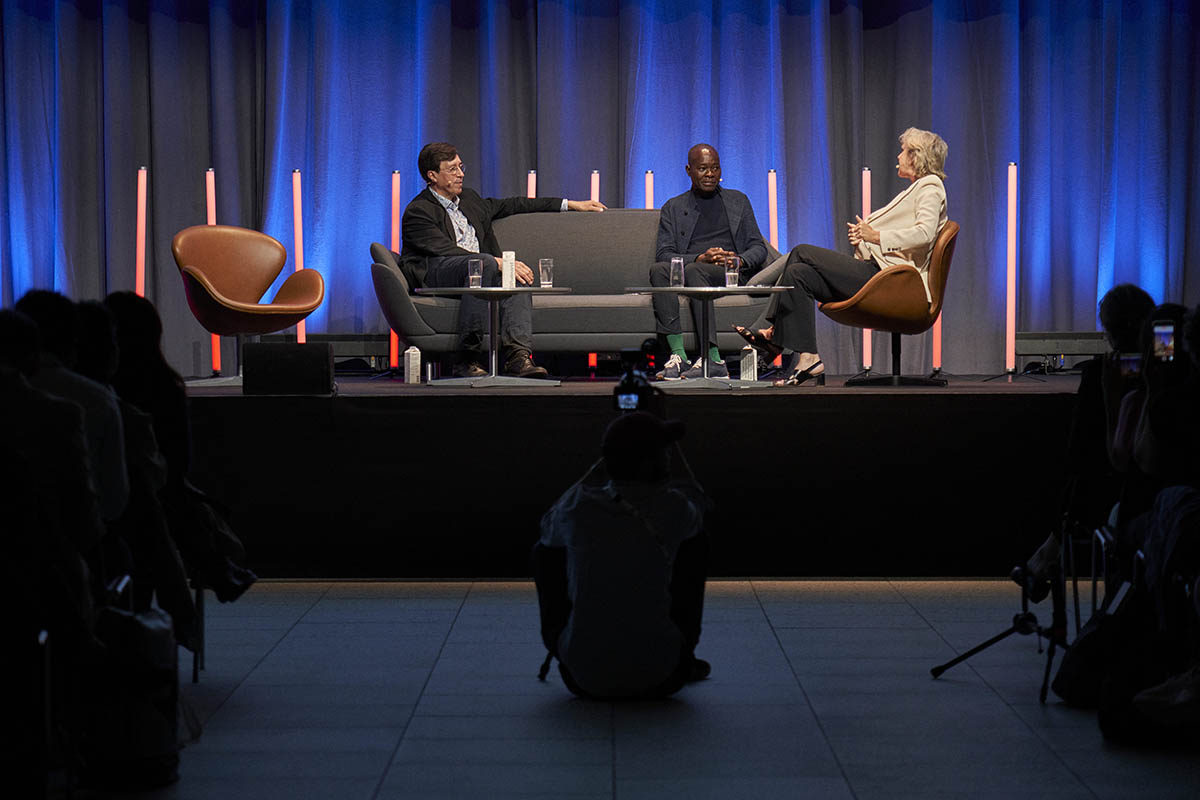
Francis Kéré and Minik Rosing in dialogue. Image courtesy of UIA World Congress of Architects 2023
"Industry wants to have a certain way of doing things"
In the keynote dialogue, Diébédo Francis Kéré also underlined that it is not easy to work with his methods and that the community actions in his place are also limited.
"Working with the ways I'm doing is not easy - neither working with community - is not easy. So that's why the community actions are limited to my village," said Diébédo Francis Kéré.
"But if we goe out we're recruiting people, of course, we're training people, which is an easy."
"I will have two to three schools in Germany that are coming out, I went through many struggles because the industry and norms and all of these implications that are needed to be sourced before you do," he continued.
"Because the industry wants to have a certain way of doing things, so everything is going to look the same as everywhere in the world."
"What we should avoid is polarization"
In response to the question of Connie Hedegaard of how do you see us and Burkina Faso as a society, the architect stated:
"We have to be careful and not to be pulled down and we have to be positive. We're going to keep building no matter what it is what will be in the world," said Diébédo Francis Kéré.
"What we should avoid is polarization. In Burkina Faso or many places in Africa where I'm working you have just people that are looking forward to have structures, housing that are inspiring them."
"That will give them a chance to lead a good life with their families and the same it is in the West. We have a climate difference and sometimes resources are needed be sourced in a different way. But it is the same battle. What we should do is to learn from each other."
"We try to create space or try to care for human being for ourselves," Kéré added.
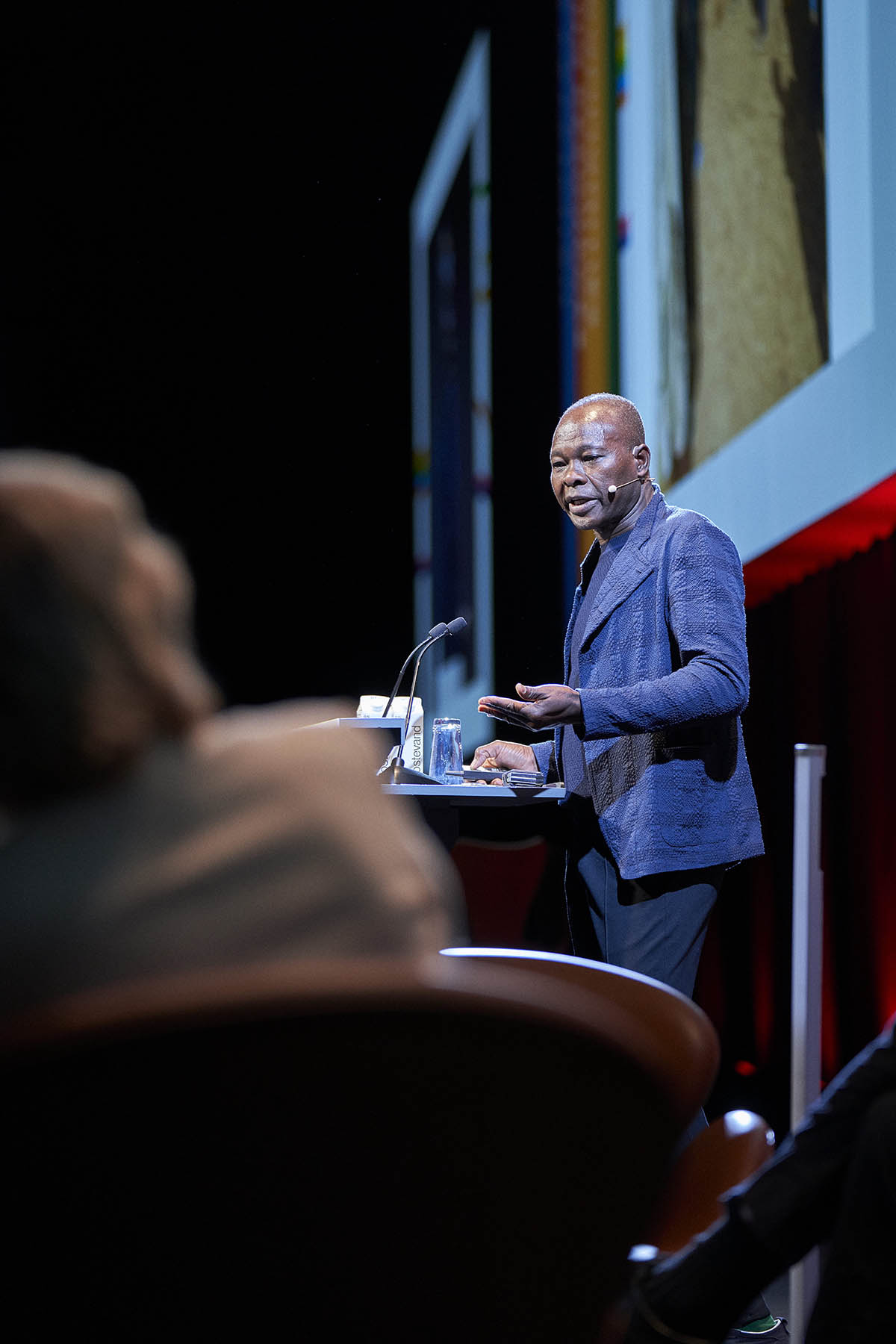
Diébédo Francis Kéré delivered a keynote speech at the UIA World Congress of Architects. Image courtesy of UIA World Congress of Architects 2023
Upon the question of Connie Hedegaard, "is it true that people always aspire sort of true to their context?", the architect explained that "If we consider the climate, it is important to try to work and create a building that fit within the context. Some people may be inspired by morals so being in Africa by models that you see in the West. But you have to adapt it."
"It is not about saying it should be a different concept because it has to be but a concept that is adapting the way that it can serve people. I am inspired by architecture," Kéré added.
"I didn't show you great examples that I'm working on that and will come a lot of projects, including museums but where I was able to use material because I convinced they fit the best."
"So energy should be an issue if you build in Burkina Faso that is seen as one of the poorest countries in the world and you try to take a Nordic model and you apply it one by one - it is not working – with the same like these well-ventilated open structure can not work here.
"So we have to always adapt ourselves. I think that is so important to create comfort for the people," Kéré continued.

Diébédo Francis Kéré delivered a keynote speech at the UIA World Congress of Architects. Image courtesy of UIA World Congress of Architects 2023
“I don't call myself a purist, I rather call myself a material opportunist”
When asked by Connie Hedegaard whether the architect was outspoken enough and whether he was pushing the sector, Kéré explained that "we have limitation and that is fact so if you have a building project and you start to fight and to get it fixed first the idea get clear and to get it done."
"Where do you take the time to fight a regulator if you don't join effort? So you will spend your time and just running if it's just you. There must be something a sort of movement just to print the finger of that," he continued.
"I don't think that those regulators are not aware of about that because we are too lazy to change our habit," he added.
Kéré said that "I don't call myself a purist; I rather call myself a material opportunist."
"I will see in the even place what is abundant and understand how can I use this in a very efficient way. So if something is made artificially with plastic that I can contribute to create like a little quantity to create more then I will go with it."
"I'm using also concrete - it's about being smart trying to find way how you really can create something that just work very well first for the users to create comfort," he added.
Renovation and Recycling
The last part of the session focused on renovation and recycling.
"If a building has proven during hundreds of years that it is solid and there is no danger to human being why should I take it down? We have always ways to add something," said Diébédo Francis Kéré.
"If there is a danger for human being, you have to fix it - we have clever engineers that will help to do."
"It is clear that is a contribution to creating more space. Sometime all of these buildings are in very exclusive part of a city and they have history and I think that is a pattern of human life."
"It has just traces and we add our little thing just to get more value but it's also grounding us and we cannot keep tearing everything down. It's against human nature," Kéré added.
Watch the video of the keynote here.
Top image in the article: Diébédo Francis Kéré. Image courtesy of UIA World Congress of Architects 2023.
> via UIA World Congress of Architects
Diébédo Francis Kéré Kéré Architecture news UIA World Congress of Architects
